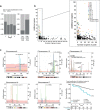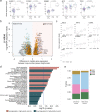Gene expression profiles of CMS2-epithelial/canonical colorectal cancers are largely driven by DNA copy number gains
- PMID: 31308487
- PMCID: PMC6756070
- DOI: 10.1038/s41388-019-0868-5
Gene expression profiles of CMS2-epithelial/canonical colorectal cancers are largely driven by DNA copy number gains
Abstract
About 80% of colorectal cancers (CRCs) have chromosomal instability, which is an integral part of aggressive malignancy development, but the importance of specific copy number aberrations (CNAs) in modulating gene expression, particularly within the framework of clinically relevant molecular subtypes, remains mostly elusive. We performed DNA copy number profiling of 257 stage I-IV primary CRCs and integrative gene expression analysis in 151 microsatellite stable (MSS) tumors, focusing on high-level amplifications and the effect of CNAs on the characteristics of the gene expression-based consensus molecular subtypes (CMS). The results were validated in 323 MSS tumors from TCGA. Novel recurrent high-level amplifications (≥15 additional copies) with a major impact on gene expression were found for TOX3 (16q) at 1.5% frequency, as well as for CCND2 (12p) and ANXA11 (10q) at 1% frequency, in addition to the well-known targets ERBB2 (17q) and MYC (8q). Focal amplifications with ≥15 or ≥5 additional copies of at least one of these regions were associated with a poor overall survival among patients with stage I-III MSS CRCs (multivariable hazard ratio ≥3.2, p ≤ 0.01). All high-level amplifications were focal and had a more consistent relationship with gene expression than lower amplitude and/or broad-range amplifications, suggesting specific targeting during carcinogenesis. Genome-wide, copy number driven gene expression was enriched for pathways characteristic of the CMS2-epithelial/canonical subtype, including DNA repair and cell cycle progression. Furthermore, 50% of upregulated genes in CMS2-epithelial/canonical MSS CRCs were driven by CNAs, an enrichment compared with the other CMS groups, and associated with the stronger correspondence between CNAs and gene expression in malignant epithelial cells than in the cells of the tumor microenvironment (fibroblasts, endothelial cells, leukocytes). In conclusion, we identify novel recurrent amplifications with impact on gene expression in CRC and provide the first evidence that CMS2 may have a stronger copy-number related genetic basis than subtypes more heavily influenced by gene expression signals from the tumor microenvironment.
Conflict of interest statement
The authors declare that they have no conflict of interest.
Figures




Similar articles
-
Consensus molecular subtype classification of colorectal adenomas.J Pathol. 2018 Nov;246(3):266-276. doi: 10.1002/path.5129. Epub 2018 Aug 31. J Pathol. 2018. PMID: 29968252 Free PMC article.
-
Gene expression profiles in genome instability-based classes of colorectal cancer.BMC Cancer. 2018 Dec 18;18(1):1265. doi: 10.1186/s12885-018-5174-z. BMC Cancer. 2018. PMID: 30563495 Free PMC article.
-
Functionally-focused algorithmic analysis of high resolution microarray-CGH genomic landscapes demonstrates comparable genomic copy number aberrations in MSI and MSS sporadic colorectal cancer.PLoS One. 2017 Feb 23;12(2):e0171690. doi: 10.1371/journal.pone.0171690. eCollection 2017. PLoS One. 2017. PMID: 28231327 Free PMC article.
-
Molecular pathological classification of colorectal cancer.Virchows Arch. 2016 Aug;469(2):125-34. doi: 10.1007/s00428-016-1956-3. Epub 2016 Jun 20. Virchows Arch. 2016. PMID: 27325016 Free PMC article. Review.
-
The Potential Value of Immunotherapy in Colorectal Cancers: Review of the Evidence for Programmed Death-1 Inhibitor Therapy.Clin Colorectal Cancer. 2016 Dec;15(4):285-291. doi: 10.1016/j.clcc.2016.07.007. Epub 2016 Jul 22. Clin Colorectal Cancer. 2016. PMID: 27553906 Review.
Cited by
-
Precision Medicine in Metastatic Colorectal Cancer: Targeting ERBB2 (HER-2) Oncogene.Cancers (Basel). 2022 Jul 30;14(15):3718. doi: 10.3390/cancers14153718. Cancers (Basel). 2022. PMID: 35954382 Free PMC article. Review.
-
CNApp, a tool for the quantification of copy number alterations and integrative analysis revealing clinical implications.Elife. 2020 Jan 15;9:e50267. doi: 10.7554/eLife.50267. Elife. 2020. PMID: 31939734 Free PMC article.
-
Investigation of colorectal cancer in accordance with consensus molecular subtype classification.Ann Gastroenterol Surg. 2020 Jul 21;4(5):528-539. doi: 10.1002/ags3.12362. eCollection 2020 Sep. Ann Gastroenterol Surg. 2020. PMID: 33005848 Free PMC article. Review.
-
Clinical Value of Consensus Molecular Subtypes in Colorectal Cancer: A Systematic Review and Meta-Analysis.J Natl Cancer Inst. 2022 Apr 11;114(4):503-516. doi: 10.1093/jnci/djab106. J Natl Cancer Inst. 2022. PMID: 34077519 Free PMC article.
-
From Subtypes to Solutions: Integrating CMS Classification with Precision Therapeutics in Colorectal Cancer.Curr Treat Options Oncol. 2024 Dec;25(12):1580-1593. doi: 10.1007/s11864-024-01282-5. Epub 2024 Nov 26. Curr Treat Options Oncol. 2024. PMID: 39589648 Review.
References
-
- Sartore-Bianchi A, Trusolino L, Martino C, Bencardino K, Lonardi S, Bergamo F, et al. Dual-targeted therapy with trastuzumab and lapatinib in treatment-refractory, KRAS codon 12/13 wild-type, HER2-positive metastatic colorectal cancer (HERACLES): a proof-of-concept, multicentre, open-label, phase 2 trial. Lancet Oncol. 2016;17:738–46. doi: 10.1016/S1470-2045(16)00150-9. - DOI - PubMed
Publication types
MeSH terms
LinkOut - more resources
Full Text Sources
Medical
Research Materials
Miscellaneous

